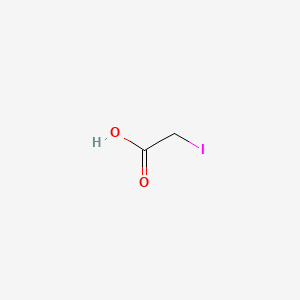| MeSH term | MeSH ID | Detail |
|---|---|---|
| Cumulative Trauma Disorders | D012090 | 2 associated lipids |
| Monckeberg Medial Calcific Sclerosis | D050380 | 1 associated lipids |
| Clonorchiasis | D003003 | 1 associated lipids |
| Osteoarthritis, Spine | D055013 | 2 associated lipids |
Iodoacetic acid
Iodoacetic acid is a lipid of Fatty Acyls (FA) class. Iodoacetic acid is associated with abnormalities such as Photoreceptor degeneration and Post MI. The involved functions are known as Hypoxia, Glycolysis, Metabolic Inhibition, Oxidation and PTPS activity. Iodoacetic acid often locates in Extracellular, Muscle, Mitochondria, Cytoplasmic matrix and Tissue membrane. The associated genes with Iodoacetic acid are SLC33A1 gene, GTF2I gene, Mutant Proteins, TRIM33 gene and oxytocin, 1-desamino-(O-Et-Tyr)(2)-.
Cross Reference
Introduction
To understand associated biological information of Iodoacetic acid, we collected biological information of abnormalities, associated pathways, cellular/molecular locations, biological functions, related genes/proteins, lipids and common seen animal/experimental models with organized paragraphs from literatures.
What diseases are associated with Iodoacetic acid?
Iodoacetic acid is suspected in Photoreceptor degeneration, Post MI and other diseases in descending order of the highest number of associated sentences.
Related references are mostly published in these journals:
| Disease | Cross reference | Weighted score | Related literature |
|---|
Possible diseases from mapped MeSH terms on references
We collected disease MeSH terms mapped to the references associated with Iodoacetic acid
PubChem Associated disorders and diseases
What pathways are associated with Iodoacetic acid
There are no associated biomedical information in the current reference collection.
PubChem Biomolecular Interactions and Pathways
Link to PubChem Biomolecular Interactions and PathwaysWhat cellular locations are associated with Iodoacetic acid?
Visualization in cellular structure
Associated locations are in red color. Not associated locations are in black.
Related references are published most in these journals:
| Location | Cross reference | Weighted score | Related literatures |
|---|
What functions are associated with Iodoacetic acid?
Related references are published most in these journals:
| Function | Cross reference | Weighted score | Related literatures |
|---|
What lipids are associated with Iodoacetic acid?
There are no associated biomedical information in the current reference collection.
What genes are associated with Iodoacetic acid?
Related references are published most in these journals:
| Gene | Cross reference | Weighted score | Related literatures |
|---|
What common seen animal models are associated with Iodoacetic acid?
There are no associated biomedical information in the current reference collection.
NCBI Entrez Crosslinks
All references with Iodoacetic acid
Download all related citations| Authors | Title | Published | Journal | PubMed Link |
|---|---|---|---|---|
| Wrathmell AB and Alexander P | Immunogenicity of a rat leukaemia of spontaneous origin (SAL). | 1976 | Br. J. Cancer | pmid:769814 |
| Ueda T et al. | Detection of subtle differences in the surface structure of lysozymes by use of an immobilized Fab fragment. | 1993 | J. Biochem. | pmid:7682215 |
| Koekemoer TC et al. | Isolation and characterization of adipose tissue glycerol-3-phosphate dehydrogenase. | 1995 | Int. J. Biochem. Cell Biol. | pmid:7671141 |
| Gardiner TH and Goodman FR | Comparison of uptake and binding of disodium cromoglycate and phenol red in rat lung. | 1976 | J. Pharmacol. Exp. Ther. | pmid:7666 |
| Borle AB and Barsic M | Chemical hypoxia increases cytosolic Ca2+ and oxygen free radical formation. | 1995 | Cell Calcium | pmid:7664318 |
| Wagner DR et al. | The AMP-adenosine cycle is active during normoxia and impaired in ATP depletion in isolated rabbit cardiomyocytes. | 1994 | Adv. Exp. Med. Biol. | pmid:7660919 |
| Thomas JA et al. | Analysis of cells and tissues for S-thiolation of specific proteins. | 1995 | Meth. Enzymol. | pmid:7651223 |
| Wright SK et al. | Mechanistic studies on malate dehydrogenase from Escherichia coli. | 1995 | Arch. Biochem. Biophys. | pmid:7646053 |
| Rabaste F et al. | Modifications of pH and K+ gradients in Candida albicans blastospores induced by amphotericin B. A 31P NMR and K+ atomic absorption study. | 1995 | Biochim. Biophys. Acta | pmid:7626662 |
| Hattori A and Takahashi K | Studies on the post-mortem fragmentation of myofibrils. | 1979 | J. Biochem. | pmid:762051 |
| Matsumoto Y et al. | Creatine kinase kinetics in diabetic cardiomyopathy. | 1995 | Am. J. Physiol. | pmid:7611380 |
| Kawanishi T et al. | Suppression of Na+ influx in ATP-depleted hepatocytes. | 1995 | Life Sci. | pmid:7603308 |
| Martenson CH et al. | The effect of acrylamide and other sulfhydryl alkylators on the ability of dynein and kinesin to translocate microtubules in vitro. | 1995 | Toxicol. Appl. Pharmacol. | pmid:7597712 |
| Denu JM and Dixon JE | A catalytic mechanism for the dual-specific phosphatases. | 1995 | Proc. Natl. Acad. Sci. U.S.A. | pmid:7597052 |
| Bennett TA et al. | Evidence for a third component in neutrophil aggregation: potential roles of O-linked glycoproteins as L-selectin counter-structures. | 1995 | J. Leukoc. Biol. | pmid:7595051 |
| Omote H et al. | Beta subunit Glu-185 of Escherichia coli H(+)-ATPase (ATP synthase) is an essential residue for cooperative catalysis. | 1995 | J. Biol. Chem. | pmid:7592742 |
| Kawasaki H et al. | Use of haloacetate dehalogenase genes as selection markers for Escherichia coli and Pseudomonas vectors. | 1995 | Biodegradation | pmid:7579995 |
| Kanaani J et al. | Identification of the active sites of human and schistosomal hypoxanthine-guanine phosphoribosyltransferases by GMP-2',3'-dialdehyde affinity labeling. | 1995 | Biochemistry | pmid:7578112 |
| Ogata T et al. | A possible mechanism for the hypoxia-hypoglycemia-induced release of excitatory amino acids from cultured hippocampal astrocytes. | 1995 | Neurochem. Res. | pmid:7566371 |
| Holland R and Elek G | Study on the "toxic oxygen effect" of Janus green B in mouse ascites tumour cells. | 1978 | Strahlentherapie | pmid:75598 |
